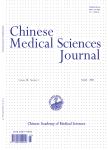Early Warning of Acute Altitude Sickness by Physiological Variables and Noninvasive Cardiovascular Indicators
Early Warning of Acute Altitude Sickness by Physiological Variables and Noninvasive Cardiovascular Indicators作者机构:Department of CardiologyChinese PLA General HospitalBeijing 100853China
出 版 物:《Chinese Medical Sciences Journal》 (中国医学科学杂志(英文版))
年 卷 期:2020年第35卷第1期
页 面:13-19页
核心收录:
基 金:National Science and Technology Major Projects for Major New Drugs Innovation and Development(2014ZX09J14102-02A) Special Topic on Military Health Care(17bjz41) National Natural Science Foundation of China(81170249 and 30700305).
主 题:acute altitude sickness physiological variables noninvasive cardiovascular indicators acute high altitude exposure early warning
摘 要:Objective To examine if the variations at sea level would be able to predict subsequent susceptibility to acute altitude sickness in subjects upon a rapid ascent to high altitude.Methods One hundred and six Han nationality male individuals were recruited to this research.Dynamic electrocardiogram,treadmill exercise test,echocardiography,routine blood examination and biochemical analysis were performed when subjects at sea level and entering the plateau respectively.Then multiple regression analysis was performed to construct a multiple linear regression equation using the Lake Louise Score as dependent variable to predict the risk factors at sea level related to acute mountain sickness(AMS).Results Approximately 49.05%of the individuals developed AMS.The tricuspid annular plane systolic excursion(22.0+2.66 vs.23.2+3.19 mm,t=l.998,P=0.048)was significantly lower in the AMS group at sea level,while count of eosinophil[(0.264+0.393)×109/L vs.(0.126+0.084)×109/L,t=-2.040,P—0.045],percentage of diflerences exceeding 50 ms between adjacent normal number of intervals(PNN50,9.66%±5.40%vs.6.98%±5.66%,t=-2.229,P=0.028)and heart rate variability triangle index(57.1+16.1 vs.50.6+12.7,t=-2.271,P=0.025)were significantly higher.After acute exposure to high altitude,C-reactive protein(0.098+0.103 vs.0.062+0.045 g/L,t=-2.132,P=0.037),aspartate aminotransferase(19.7+6.7275.17,3±3.95 U/L,t=-2.231,P=0.028)and creatinine(85.1±12.9 vs.77.7±11.2 mmol/L,t=3.162,P=0.002)were significantly higher in the AMS group,while alkaline phosphatase(71.7+18.2 vs.80.6+20.2 U/L,t=2.389,P=0.019),standard deviation of normal-to-normal RR intervals(126.5+35.9 vs.143.3+36.4 ms,t—2.320,P—0.022),ejection time(276.9+50.8 vs.313.8+48.9 ms,t—3.641,P—0.001)and heart rate variability triangle index(37.1+12.9 vs.41.9+11.1,t=2.O2O,P=0.047)were significantly lower.Using the Lake Louise Score as the dependent variable,prediction equation were established to estimate AMS:Lake Louise Score=3.783+0.281Xeosinophil-0.219Xalkaline phosphatase+O.O32XPNN50.Conclusions We elucidated the differences of pl^siological variables as well as noninvasive cardiovascular indicators for subjects after high altitude exposure compared with those at sea level.We also created an acute high altitude reaction early warning equation based on the physiological variables and noninvasive cardiovascular indicators at sea level.



